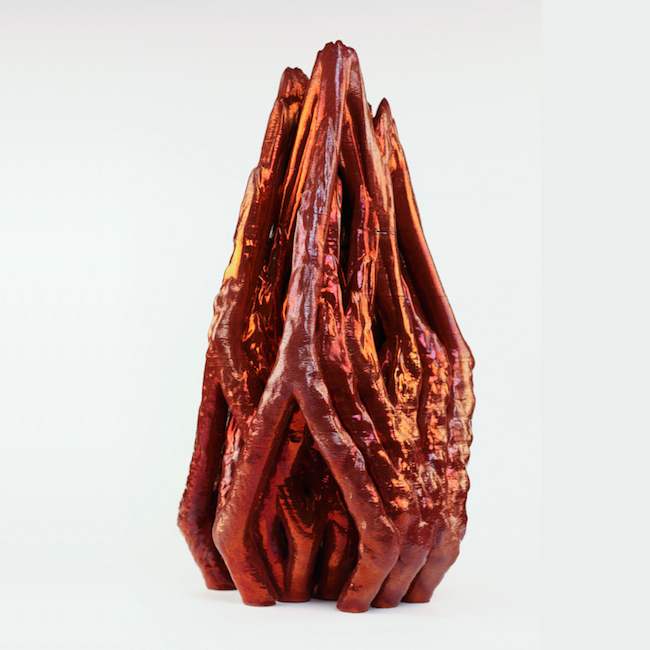MILAN, ITALY — One of the fun things about 3D printing are the names. Without a doubt this technology has some of the coolest handles to come out of startups. For purely nerdy reasons I’m a big fan of MakerBot, but Italian company WASP (World’s Advanced Saving Project) is a close second.

Francesco Pacelli, Pyromania, 2015, ceramics and full-fire reduction, 61 cm high. Click to see a larger image.
We say this every time we talk about 3D printing, but it needs to be repeated: this is a technology that is still in its infancy. If you think about it in terms of computers, we’re still messing around with tape drives. The tech is out there, you can see some of its achievements, but there’s still ground to be covered. As with the early days of computers, many of these machines are out of the average person’s price range.
But that won’t always be the case. These machines will eventually find their way into homes and studios and the industry needs to be ready when they do. We’ve covered the work of Olivier van Herpt in depth, but another artist, Italian Francesco Pacelli, is also getting in on the 3D-printed clay game. He’s partnered with WASP to develop techniques for what the company calls Liquid Deposition Modeling, or LDM. He states:
All art has been contemporary. I truly believe in developing concepts and thoughts combining the newest techniques and today’s tools, however not forgetting the oldest ones, mixing digital and analog, virtual and physical, faith and science. As an artist I’ll try to communicate the importance of sharing ideas, techniques, minds, as a fundamental part of the evolutive process of knowledge.



Francesco Pacelli, Robotic Woman Nursing a Baby, 2015, ceramics and glaze, 54 cm height
I like the organic, almost sci-fi look of many of these works. It’s a refreshing complexity from what we’ve seen so far with 3D printed sculpture. With many works you can see the threads left behind by the machine. They look more like artifacts of the process than a deliberate choice by the maker. It’s getting distracting and it certainly provides ammunition to luddites. There are still threads in Pacelli’s but the complexity is starting to move forward. It’s going to be an awkward couple of years to be sure, but I think more and more people like Pacelli will float to the surface.
Pacelli was born in Perugia, Italy in 1988. Today he works in Milan and Massa Lombarda. He graduated from Design & Engineering from Politecnico di Milano, Italy in 2013. He is the first place prize recipient of the Ceramic Futures 2.0 contest.
Bill Rodgers is the Managing Editor of cfile.daily.
Do you love or loathe these works of contemporary ceramic art? Let us know in the comments.

Francesco Pacelli, Metal mangrove, 2015, ceramics and full-fire reduction, 39 cm height. Click to see a larger image

Francesco Pacelli. Photographs courtesy of the artist.



“…look more like artifacts of the process than a deliberate choice by the maker.” While this is still the case, I would agree that these go further than most 3Dprinted ceramics I’ve encountered to date. Those works have all made me wonder whether, but for their status as having been created by new technology, they would be exhibited at all. These works by Pacelli have me wondering why the technology is necessary here; the work feels as though it could be executed by a more direct technique. I completely agree that we are at the awkward stage with 3D printed ceramics; there needs to be more mass availability and experimentation before work that is not a visual slave to the process is produced. Can’t wait!
Apart fropm a rather infantile delight in what “fun” you can have with this technology, what is the point of this. Oh, apart from using up the earths resources to create more landfill?